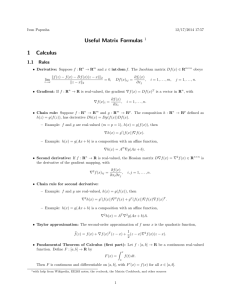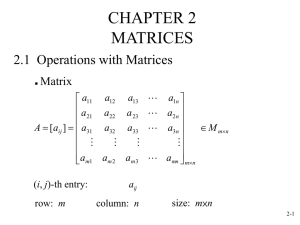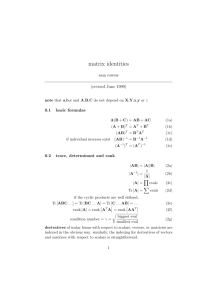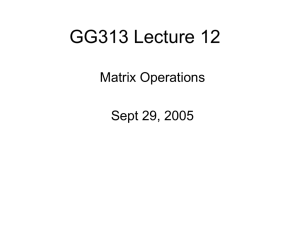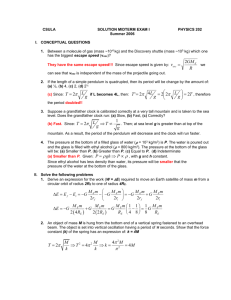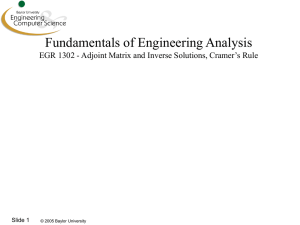pptx - Texas A&M University
advertisement
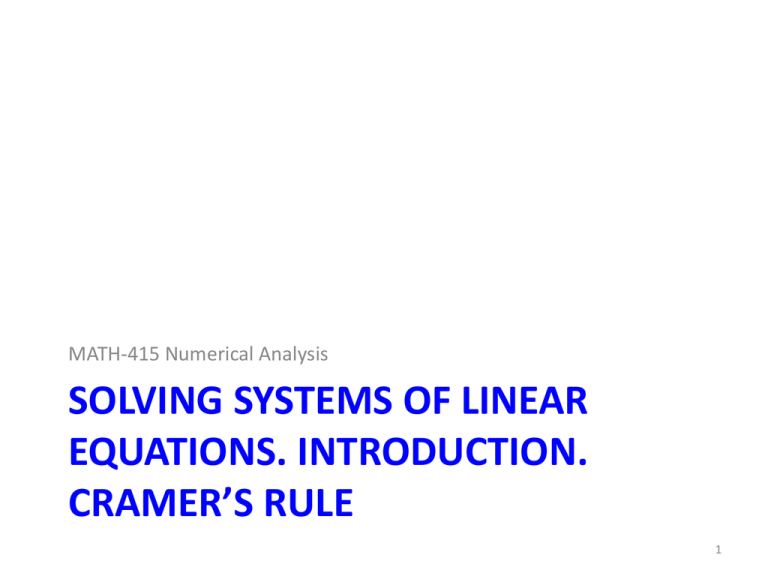
MATH-415 Numerical Analysis SOLVING SYSTEMS OF LINEAR EQUATIONS. INTRODUCTION. CRAMER’S RULE 1 Linear Algebraic Equations • An equation of the form ax+by+c=0 or ax+by=-c is called a linear equation in unknowns x and y • ax+by+cz=d is a linear equation in three unknowns x, y, and z • Thus, a linear equation in n unknowns is a1x1+a2x2+ … +anxn = b a1 ,..., an , b R or a1 ,..., an , b C • A solution of such an equation consists of numbers c 1 , c2 , c3 , … , cn • If we need to work more than one linear equations, a set (system) of linear equations must be solved simultaneously 2 Systems of Linear Equations a11 x1 a12 x2 a13 x3 b1 a21 x1 a22 x2 a23 x3 b2 a31 x1 a32 x2 a33 x3 b3 In a matrix form: a11 a 21 a31 a12 a22 a32 a13 a23 a33 x1 b1 x b 2 2 x3 b3 Ax b Systems of Linear Equations • Solve Ax=b, where A is an nn matrix and b is an n1 column vector • Can also talk about non-square systems where A is mn, b is m1, and x is n1 Overdetermined if m>n: “more equations than unknowns” Underdetermined if n>m: “more unknowns than equations” Square Matrices • A square matrix of order n contains the same number of rows and columns a11 a 21 A a31 an1 a12 a22 a32 a13 a23 a33 an 2 ... a1n ann • Square matrices are particularly important when a system of equations to be solved 5 A Symmetric Matrix • A square matrix is called a symmetric matrix when the pairs of elements with the symmetric indexes across the diagonal are aij a ji ; i, j 1,..., n equal a11 x y x a22 z y z a33 6 The Transpose of a Matrix • The transpose of a matrix is a matrix obtained by writing the rows as columns or (which is the same) by writing the columns as rows A aij ; AT a ji a11 a A 21 ... an1 a12 a22 ... an 2 ... a1n a11 ... a2 n T a12 ;A ... ... ... ... ann a1n a21 a22 ... a2 n ... an1 ... an 2 ... ... ... ann 7 Diagonal Matrix • If all elements in a square matrix except those on the main diagonal are zero, the matrix is called a diagonal matrix a11 0 A 0 0 0 0 a22 ... ... ... ... 0 ... ... ... 0 an 1n 1 ... 0 0 0 0 0 ann 8 Triangular Matrices • A square matrix is called triangular if all the elements above or below diagonal are zeros 0 ... 0 a • Lower-triangular 11 • Upper-triangular a21 ... an1 a22 ... an 2 0... a11 0 0 0 a12 a22 0 0 ... a1n ... a2 n ... 0 ann ... 0 0 ann 9 Identity Matrix • If the nonzero elements of a diagonal matrix of order n all are equal to 1 , the matrix is called the identity matrix of order n 1 0 I n 0 0 0 0 ... ... 0 1 0 ... 0 ... ... 0 ... 0 1 0 ... ... 0 1 • For any square matrix A of order n I n A AI n A 10 Transposition Matrix • If two rows of an identity matrix are interchanged, it is called a transposition matrix 1 0 I4 0 0 0 1 0 0 0 0 1 0 0 1 0 0 0 2 nd and 4th rows are interchanged 0 1 0 0 0 0 1 0 0 1 0 0 1 P24 P42 0 0 11 Transposition Matrix • If a transposition matrix is multiplied with a square matrix A of the same size, the product will be the A matrix, but with the same two rows interchanged as in the transposition matrix 9 4 A 0 3 6 2 7 2 2 13 1 0 8 11 ; P24 A 0 1 9 6 8 0 0 0 0 1 0 0 1 0 0 9 1 4 0 0 0 3 6 2 7 2 2 13 9 8 11 3 1 9 0 6 8 4 6 2 7 2 2 13 6 8 1 9 8 11 12 Transposition Matrix • If a square matrix A is multiplied with the transposition matrix P of the same size, the product will be the A matrix, but with the columns of A interchanged according to the rows of P interchanged 9 4 A 0 3 6 2 7 2 2 13 9 4 8 11 ; AP24 0 1 9 6 8 3 6 2 7 2 2 13 1 0 0 8 11 0 0 0 1 9 0 0 1 6 8 0 1 0 0 9 13 2 6 1 4 11 8 2 0 0 9 1 7 0 3 8 6 2 13 Permutation Matrix • A permutation matrix is obtained by multiplying several transposition matrices 1 0 P24 P12 0 0 9 4 A 0 3 6 2 7 2 1 0 0 0 0 0 1 0 0 0 0 0 0 0 1 1 1 0 0 0 0 0 1 0 2 13 0 0 8 11 ; PA P24 P12 A 0 1 9 6 8 1 1 0 0 0 0 0 1 0 0 9 1 4 0 0 0 3 6 2 7 2 2 13 4 8 11 3 1 9 0 6 8 9 0 0 0 1 0 0 1 0 0 0 1 1 0 0 0 0 0 1 P 0 0 2 2 7 6 8 11 6 8 1 9 2 13 14 Permutation • A permutation is a function that reorders an ordered set of integers. This function can be determined by a table containing two rows: the 1st row contains the integers in the initial order, the 2nd row contains the corresponding reordered set 1 2 ... n ; i 1,..., n , i 1,..., n 1 2 ... n • Symbols r and s in a permutation create an inversion if r>s and r precedes s : 1 2 3 4 n 1 2 ... 2 1 4 3 1 r ... s ... n 2,1 and 4,3 are inversions • A permutation is even if it contains the even number of inversions , and it is odd if it contains the odd number of inversions 15 Permutation and Permutation Matrix • A permutation corresponding to a permutation matrix determines a new order of rows: 1 0 P24 P12 0 0 0 0 0 1 0 0 1 0 0 0 1 1 0 0 0 0 1 0 0 0 0 0 1 0 0 0 0 0 0 0 1 1 1 0 0 0 0 0 1 0 0 1 P 0 0 1 2 3 4 2 4 3 1 16 Determinant • A determinant of order n corresponding to a given square matrix of order n is a value, which equals to the algebraic sum of n! additive terms such that every term is a product of exactly the n elements from the matrix taken by 1 from every row and every column • The additive term appears in the sum with the “+” sign if the permutation created from the numbers of rows (the 1st row of the permutation) and columns (the second row of the permutation) is even, and with the “-” sign if this permutation is odd • det(A) is a common notation for the determinant of A 17 Determinant • 2x2 matrix a11 A a21 a12 ; a22 • 3x3 matrix det( A) a11a22 a12 a21 1 2 1 2 1 2 2 1 0 invers. 1 invers. a11 a12 a13 A a21 a22 a23 ; a31 a32 a33 det( A) a11a22 a33 a12 a21a33 a13a21a32 a11a23a32 a12 a23a31 a13a12 a31 1 2 3 1 2 3 1 2 3 1 2 3 1 2 3 1 2 3 1 2 3 2 1 3 3 1 2 1 3 2 2 3 1 3 2 1 0 invers. 1 invers. 2 invers. 1 invers. 2 invers. 3 invers. 18 Singular Matrix • A matrix is called singular if its determinant equals 0 • A singular matrix is not invertible! • A matrix is always singular if some row (column) is a linear combination of some other rows (columns) a11 A ka11 a31 a12 ka12 a32 a13 a11 a12 a13 ka13 A k1a11 k2 a31 k1a12 k2 a32 k1a13 k2 a33 a31 a32 a33 a33 • A system of n linear equations in n unknowns has a single non-zero solution only if its matrix is not singular 19 Singular Systems of Linear Equations • Singular systems can be underdetermined: 2 x1 3 x2 5 4 x1 6 x2 10 (the second equation is coefficient-wise proportional to the first one) • or inconsistent: 2 x1 3x2 5 4 x1 6 x2 11 (the system matrix 2 3 4 6 is singular) Minor • Let us have an nxm matrix A. Let us choose in this matrix arbitrarily k rows and k columns k p; p min m, n . • The elements located in the intersection points of these k rows and k columns form a kxk matrix. • The determinant of this kxk matrix is called a minor of order k of the matrix A. 21 Minor • Any nxm matrix has more than 1 minor of order k<n for any k. • A rank of an nxm matrix is the highest order of a non-zero minor of this matrix a11 a12 a13 D a21 a22 a23 a31 a32 a33 D11 a22 a23 D12 a21 a23 a32 a33 a31 a33 a22 a33 a32 a23 ; a21 a33 a31 a23 ; D13 a21 a22 a31 a32 a21 a32 a31 a22 22 Systems of Linear Equations • Solve Ax=b, where A is an nn matrix and b is an n1 column vector • Usually not a good idea to compute x=A-1b Inefficient (because finding an inverse matrix is a special and computationally very costly procedure) Prone to round-off errors • So some numerical methods are needed… Systems of Linear Equations • Solve Ax=b, where A is an nm matrix and b is an m1 column vector • A is called a matrix of the system of linear equations b • A ... is an augmented n(m+1) matrix of the b system 1 m • Rouché-Kronecker-Capelli Theorem: A system of linear equations has a solution if and only if the rank of its coefficient matrix is equal to the rank of its augmented matrix Methods for Solving Systems of Equations • For small number of equations and unknowns (n ≤ 3) linear equations can be solved by simple techniques such as “method of elimination by hand” • On the other hand, Linear algebra provides the tools to solve such systems of linear equations • Nowadays, easy access to computers makes the solution of large sets of linear algebraic equations possible and practical 25 Methods for Solving Systems of Equations Solving Systems of Equations • There are many ways to solve a system of linear equations: Graphical method Cramer’s rule Method of elimination Directed elimination Other Numerical methods For small n For large n 26 Example: Graphical Method • For two equations: a11 x1 a12 x2 b1 a21 x1 a22 x2 b2 • Solve both equations for x2: a11 b1 x2 x2 (slope1 )x1 intercept1 x1 a12 a12 a21 b2 x2 x2 (slope 2 )x1 intercept 2 x1 a22 a22 by Lale Yurttas, Texas A&M University Part 3 27 • Plot x2 vs. x1 for both equations. • The intersection of the lines present the solution by Lale Yurttas, Texas A&M University 28 Graphical Method No solution by Lale Yurttas, Texas A&M University Infinite solutions Part 3 Ill-conditioned (Slopes are too close) 29 Trivial Elimination Method • For two equations: a11 x1 a12 x2 b1 a21 x1 a22 x2 b2 • Let us solve both equations for x2: 30 Trivial Elimination Method From the 1st eq. Then And now a11 a21 b1 b2 x2 x1 x1 a12 a22 a12 a22 a21 a11 b1 b2 0 x1 a12 a22 a22 a12 From the 2nd eq. b1 b2 b2 b1 a12 a22 a22 a12 x1 a21 a11 a21 a11 a a a a 22 12 22 12 x2 can now easily be found from either of the two equations 31 Cramer’s Rule • Cramer’s rule expresses the solution of a system Ax=b (where A is an nn matrix) of linear equations in terms of ratios of determinants • The unknown xi is equal to the ratio of the determinant created from the one of the matrix A by replacement of its ith column with a column of “free” coefficients to the determinant of the matrix A. 32 Cramer’s Rule • For example: Ax b a11 a12 a13 x1 b1 A a21 a22 a23 ; x x2 ; b x b2 ; D A det A a31 a32 a33 x3 b3 x1 b1 a12 a13 a11 b1 a13 a11 a12 b1 b2 a22 a23 a21 b2 a23 a21 a22 b2 b3 a32 a33 a31 b3 a33 x2 D a31 a32 b3 x3 D D 33 Cramer’s Rule • Advantage of the Cramer’s rule is its formal algebraic simplicity • Disadvantage of the Cramer’s rule is a computational complexity of determinants computation for large values of n 34
